NIGHT CLOSURES NOW CANCELED FOR THIS WEEK. Here is how to get around the Jack Peters Creek overnight closures all next week
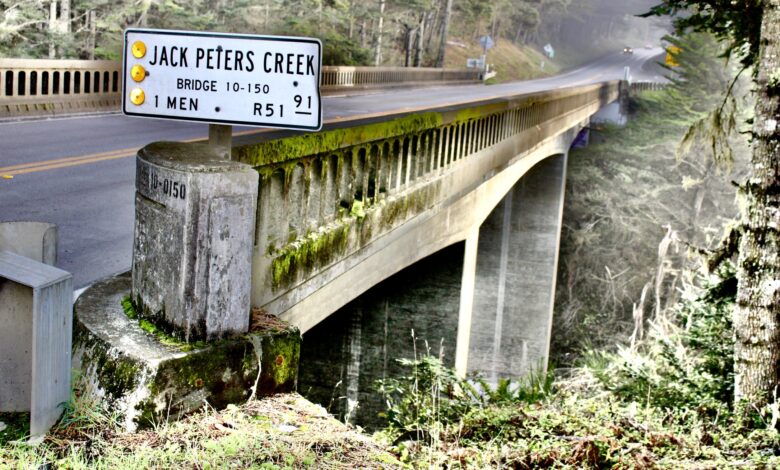
Plus- Caltrans wants to donate artificats of the old Depression Era bridge project to a museum locally! Thanks, and give us a shout!
There will be posted detours for the overnight closures of the Jack Peters Creek Bridge, which are planned to happen all next week, Monday, Sept 15-Thursday Sept 18, from 10 p.m. to 6 a.m.
This detour is thanks to signage installed for the occasion by the crews of Mendocino County Public Works Director Howard Dashiel, who has become proficient at working with Caltrans and the CHP to make closures work better over the course of closures of both the Pudding Creek Bridge and the Jack Peters Creek Bridge, and even a problem-ridden road closure on Thanksgiving due to a terrible fatal crash that blocked the Caspar Creek Bridge. The CHP has agreed to ticket big trucks that violate the prohibition on using the detours through the forest.
One persistent issue: Google Maps and other navigation apps often mislead drivers trying to cut through Jackson Demonstration State Forest. Locals learned this the hard way during last year’s closures—those directions only work if you preload them before entering, and even then, they’re unreliable. Once inside, cell reception vanishes, leaving outsiders bewildered by the coast’s wild charm. Public Works Director Howard Dashiell is especially concerned about out-of-town big rigs attempting the forest route. With gravel roads, tight turns, and no service, a stuck truck could snarl everything and require a costly tow. He’s hoping that early warnings will help prevent problems. .One significant problem is that Google Maps and other programs provide inaccurate information about navigating the Jackson Demonstration State Forest. We were told this last year during one of these events, tried it, and found out that was true. And that is only if you program your mapping program BEFORE entering the forest. There is virtually no cell reception inside the forest, a fact that freaks out outsiders about the Mendocino Coast. Daschiel is most concerned that an out-of-town big rig driver will try to cut through the forest, which is a series of gravel roads, and get stuck, tie up everything, and have to be towed out. He is hoping that getting the word out might help.
“Local people know this route and what they are getting into by taking it. Im not even that concerned by local truckers who know the limits of the road.”
Trucks will be given turnaround routes by Caltrans through Mendocino or up Point Cabrillo Drive.
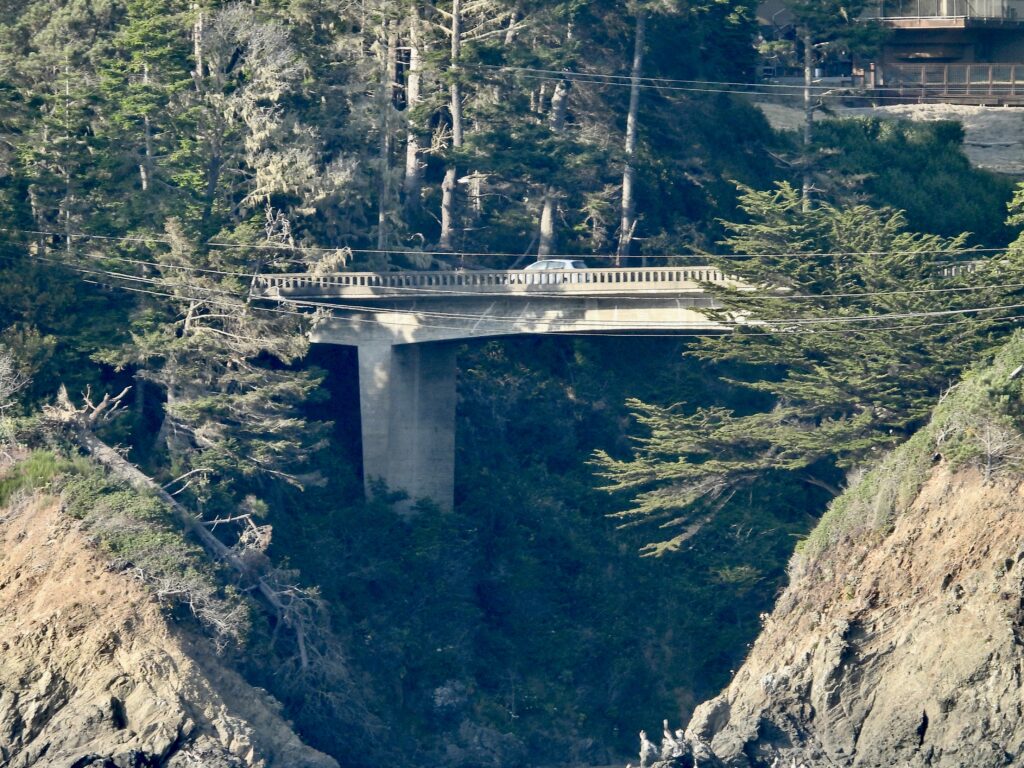
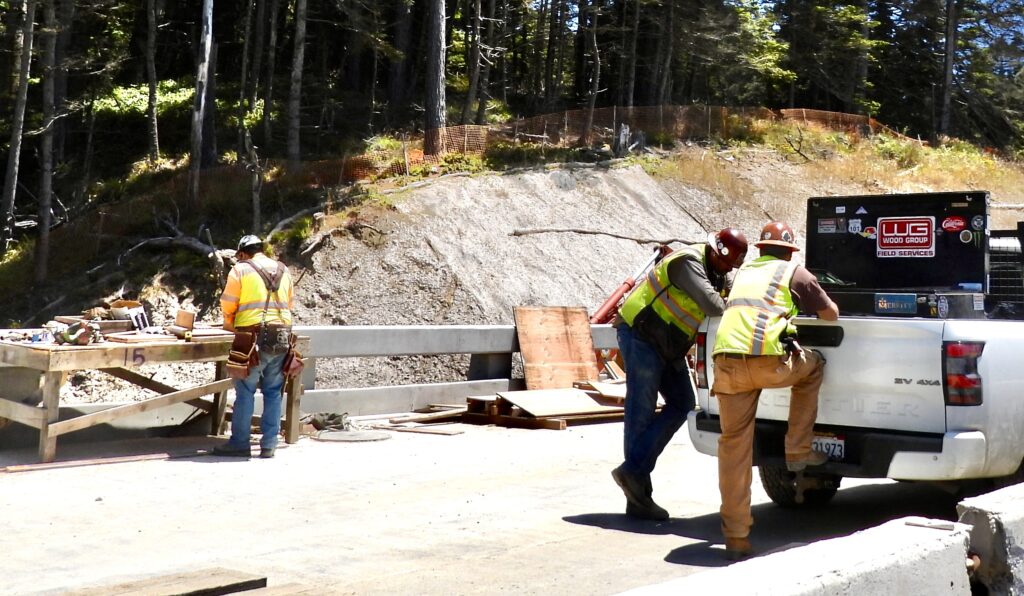
that would steady the canyon’s descent.
One ongoing challenge: Caltrans is legally restricted from directing drivers onto county roads, so their official guidance remains ‘turn around and retrace your route.’ To help reduce confusion, they’ve ramped up signage since the first Pudding Creek Bridge closure. Expect prominent road signs at key intersections—Highways 128 and 101, 128 and 20, and 20 and 1—aimed at catching drivers before they hit the barricades.
While Caltrans can’t officially direct drivers onto county roads, behind the scenes there’s been strong coordination between Caltrans, Mendocino County, and CHP to minimize disruption. A special protocol ensures first responders can pass through during emergencies—even allowing the bridge to reopen briefly mid-construction if needed. That scenario never came up during the Pudding Creek closures, though road crews once made an exception for an elderly couple who hadn’t heard about the detour and needed to get home. It’s a reminder that even in the midst of barricades and backhoes, compassion still finds a way.
“One key difference between the Pudding Creek and Jack Peters Creek closures: there’s a viable detour this time. During the Pudding Creek shutdowns, no alternate route existed—making emergency access a delicate dance. With Jack Peters, ambulance and fire crews already know the way around. And while the bridge can be reopened mid-construction for extreme emergencies, that kind of charitable exception isn’t likely now. The detour’s in place, and responders are ready.
Best to avoid this entire project overnight next week! If you can steer clear of Jack Peters Creek overnight next week, do it. Between detours, dead zones, and gravel gambles, it’s a recipe for frustration. Locals know the workarounds, but for everyone else, it’s best to plan ahead or stay put.
But if one has to drive between Caspar and the town of Mendocino during those times, here is the detour:
Nouthbound drivers can detour via Road 408 (Little Lake Road), winding through gravel forest lanes to Road 409—the one leading to the Caspar transfer station—and reconnect at Caspar Creek Bridge. But beware: Google Maps often misguides travelers, suggesting a route all the way to Highway 20. Public Works Director Howard Dashiell warns that this path may lead drivers onto locked logging roads, turning a detour into a dead end.
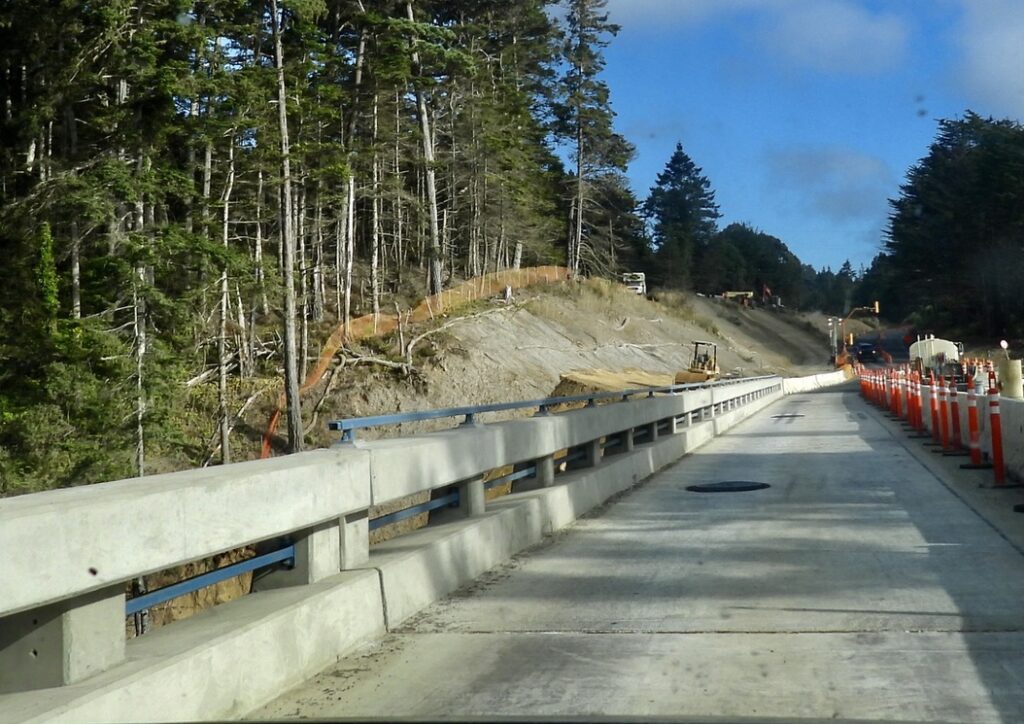
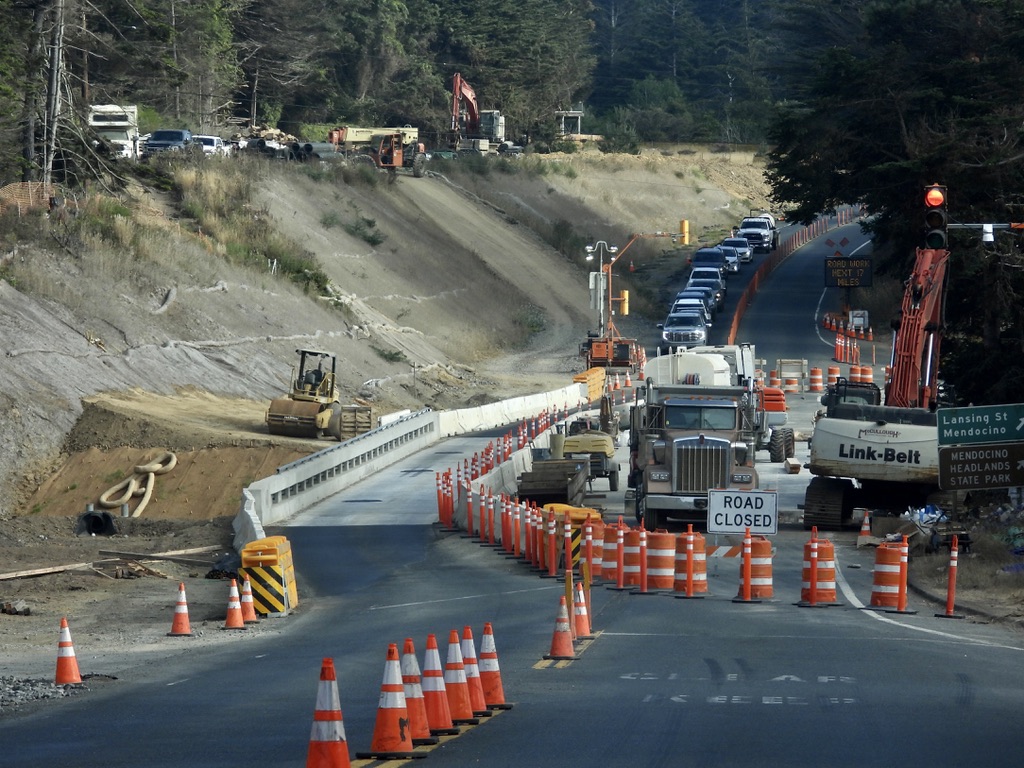
The closure will allow the contractor to apply a polyester concrete overlay that will serve as the new bridge deck surface. Motorists should plan accordingly, noting the closures are weather-dependent and subject to change. (The closures have been canceled at the last minute on numerous occasions during this process). The polyester concrete overlays, invented in 1950, have improved dramatically in the 21st century to make bridges last much longer. The use of an innovative polyester overlay saved the Jughandle Creek Bridge from needing replacement in 2007 to being fine for the future a few years later. . The flaw of these new polyester concretes is that they can only be applied when there is no rain or even heavy fog, thus the last-minute delays.
The closure will allow contractors to apply a polyester concrete overlay—a durable surface treatment that will serve as the new deck for Jack Peters Creek Bridge. These overlays, first developed in the 1950s and significantly improved in recent decades, are now a key tool in extending bridge life. In fact, a similar application saved Jughandle Creek Bridge from full replacement back in 2007, keeping it structurally sound for years to come.
Motorists should plan accordingly: closures are weather-dependent and may change with little notice. Rain, fog, or even heavy coastal mist can halt the process, and last-minute cancellations have been common throughout this project. For more on the science behind these overlays, Caltrans offers a detailed information page. everything you never knew about polyster concrete overlays
This project has required some hard-earned lessons—because overnight highway closures like this are rare, especially where no official state highway detour exists. In full bridge replacement projects, crews often rely on the old bridge as a bypass, avoiding night work altogether. And with smaller spans, replacements can be completed in a single night.
Jack Peters Creek Bridge, however, presents unique challenges—both in 1939 and today. Its short span combined with the steep canyon below has made construction unusually complex. In both eras, crews had to innovate with falsework—the temporary wooden framework used to support the bridge during construction. Back in ’39, Caltrans’ predecessor built an entire wooden bridge alongside the original just to get the job done. They did it well: the core structure remains sound and is expected to last another century.
This time, it’s the deck and rails getting a full upgrade. The old deck was too narrow for modern traffic—let alone bikes and pedestrians, who had no safe passage when cars flowed in both directions. The new deck will match the width of Pudding Creek Bridge, with shoulders, walkways, and bike lanes. It’s more than twice as wide as the original, built not just for today’s vehicles, but for a more inclusive and connected Mendocino Coast.
In a nod to history, Caltrans has uncovered artifacts from the original Jack Peters Creek Bridge and hopes to donate them to a local museum. If you’ve got ideas for where these relics might find a good home—or want to help make it happen—drop us a line at frankhartzell@gmail.com Let’s preserve a piece of Mendocino’s past together.”
Here is the Caltrans informational website on Jack Peters Creek Bridge.
Additional details from the Caltrans press release are included below.
Construction on the $15.5 million bridge widening and rail upgrade project is nearing completion. Built in 1939, the structure is being expanded to accommodate two 12-foot lanes, two 6-foot shoulders, and a 6-foot pedestrian walkway.Follow Caltrans District 1 social media for construction updates on Facebook and Twitter or visit, https://dot.ca.gov/caltrans-near-me/district-1/d1-projects/jackpetersbridgewidening.
